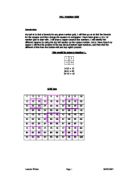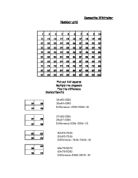Number Grid
2
3
4
5
6
7
8
9
0
1
2
3
4
5
6
7
8
9
20
21
22
23
24
25
26
27
28
29
30
31
32
33
34
35
36
37
38
39
40
41
42
43
44
45
46
47
48
49
50
51
52
53
54
55
56
57
58
59
60
61
62
63
64
65
66
67
68
69
70
71
72
73
74
75
76
77
78
79
80
81
82
83
84
85
86
87
88
89
90
91
92
93
94
95
96
97
98
99
00
First of all we need to pick a box of numbers. Like the one shown on the diagram above. This will then be used to find the product of the top left and the bottom right number in this box.
2(n)
3(n+1)
22(n+9)
23(n+11)
This shows the top left number as the lowest number which will then be multiplied against the bottom right number to find the product of the two numbers.
2 x 23 = 276
Then we need to get the product of the top right and the bottom right number to see if there is any difference in the two numbers and then see if there is any pattern or general rule to gain from this box/shape. We will be using the top right number multiplied against the bottom left number.
3 x 22 = 286
As you can see there is a difference of 10 between these two numbers, but to see if this is correct with all the other boxes in the square I will check it with another random box.
57(n)
58(n+1)
67(n+9)
68(n+11)
We will follow the same method and times the top left with the bottom right first then the top right and the bottom left afterwards. We will then see if the difference is 10, which I predict it will be.
57 x 68 = 3876
58 x 67 = 3886
As I predicted this gives a difference of 10. This means there is a general rule for all the boxes in this method. To find this rule I will have to use the algebra in the boxes as shown above.
n (n +11) = n? + 11n
We will need to find out the algebra product of the opposite way around too.
(n+10)(n+1) = n? +n+10n +10 = n? +11n +10
This proves that the differences between the two products are 10. n? +11n are the amount of the first one but n? + 11n +10 is the product of the second. The +10 shows us that the differences between the two products are 10. To test this I will use examples and see whether or not this algebra is correct or not.
Example A: n = 54
54? = 2916 + 594 (11n) = 3510
54 multiplied by 65 = 3510
Example A (1) n = 55
n? +11n +10
54? = 2916+594 +10 = 3520
Difference = 10
This proves that my general rule for each side of the box works. Now I need to see whether this is the case if I change the scale of the grid to a 6 x 6 instead of the current 10 x 10. To do this I need a grid and I need to randomly select a box and continue the method of the diagonal products of the box.
2
3
4
5
6
7
8
9
0
1
2
3
4
5
6
7
8
9
20
21
22
23
24
25
26
27
28
29
30
31
32
33
34
35
36
This box will follow the same method of multiplying the top left product with the bottom right product and vice-versa. This will help us determine whether or not this is related in some way to the 10 x 10 scale grid.
2
3
4
5
6
7
8
9
0
1
2
3
4
5
6
7
8
9
20
21
22
23
24
25
26
27
28
29
30
31
32
33
34
35
36
37
38
39
40
41
42
43
44
45
46
47
48
49
50
51
52
53
54
55
56
57
58
59
60
61
62
63
64
65
66
67
68
69
70
71
72
73
74
75
76
77
78
79
80
81
82
83
84
85
86
87
88
89
90
91
92
93
94
95
96
97
98
99
00
First of all we need to pick a box of numbers. Like the one shown on the diagram above. This will then be used to find the product of the top left and the bottom right number in this box.
2(n)
3(n+1)
22(n+9)
23(n+11)
This shows the top left number as the lowest number which will then be multiplied against the bottom right number to find the product of the two numbers.
2 x 23 = 276
Then we need to get the product of the top right and the bottom right number to see if there is any difference in the two numbers and then see if there is any pattern or general rule to gain from this box/shape. We will be using the top right number multiplied against the bottom left number.
3 x 22 = 286
As you can see there is a difference of 10 between these two numbers, but to see if this is correct with all the other boxes in the square I will check it with another random box.
57(n)
58(n+1)
67(n+9)
68(n+11)
We will follow the same method and times the top left with the bottom right first then the top right and the bottom left afterwards. We will then see if the difference is 10, which I predict it will be.
57 x 68 = 3876
58 x 67 = 3886
As I predicted this gives a difference of 10. This means there is a general rule for all the boxes in this method. To find this rule I will have to use the algebra in the boxes as shown above.
n (n +11) = n? + 11n
We will need to find out the algebra product of the opposite way around too.
(n+10)(n+1) = n? +n+10n +10 = n? +11n +10
This proves that the differences between the two products are 10. n? +11n are the amount of the first one but n? + 11n +10 is the product of the second. The +10 shows us that the differences between the two products are 10. To test this I will use examples and see whether or not this algebra is correct or not.
Example A: n = 54
54? = 2916 + 594 (11n) = 3510
54 multiplied by 65 = 3510
Example A (1) n = 55
n? +11n +10
54? = 2916+594 +10 = 3520
Difference = 10
This proves that my general rule for each side of the box works. Now I need to see whether this is the case if I change the scale of the grid to a 6 x 6 instead of the current 10 x 10. To do this I need a grid and I need to randomly select a box and continue the method of the diagonal products of the box.
2
3
4
5
6
7
8
9
0
1
2
3
4
5
6
7
8
9
20
21
22
23
24
25
26
27
28
29
30
31
32
33
34
35
36
This box will follow the same method of multiplying the top left product with the bottom right product and vice-versa. This will help us determine whether or not this is related in some way to the 10 x 10 scale grid.







